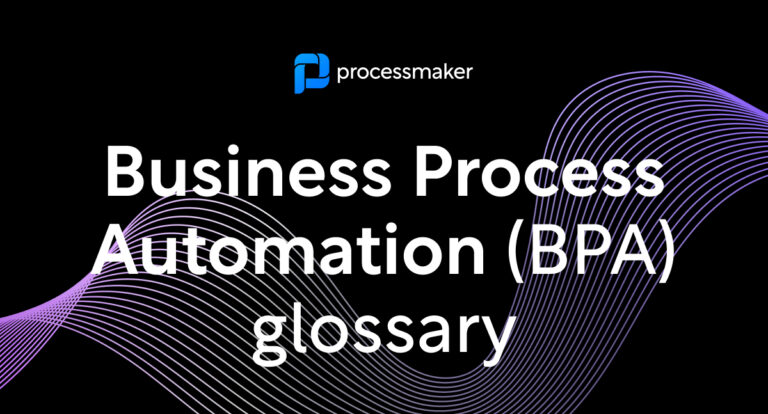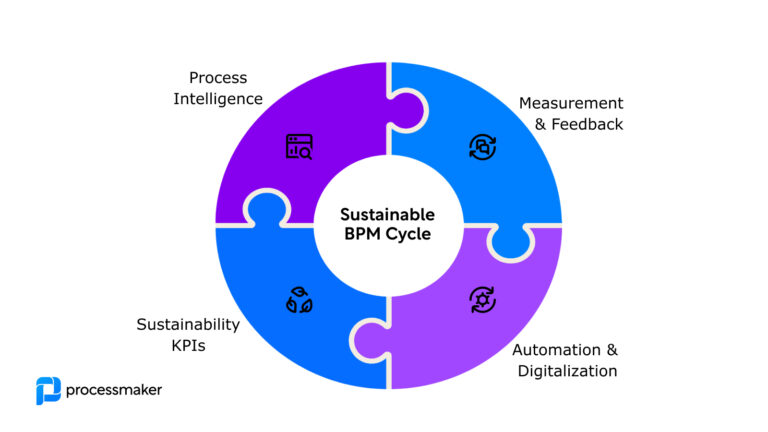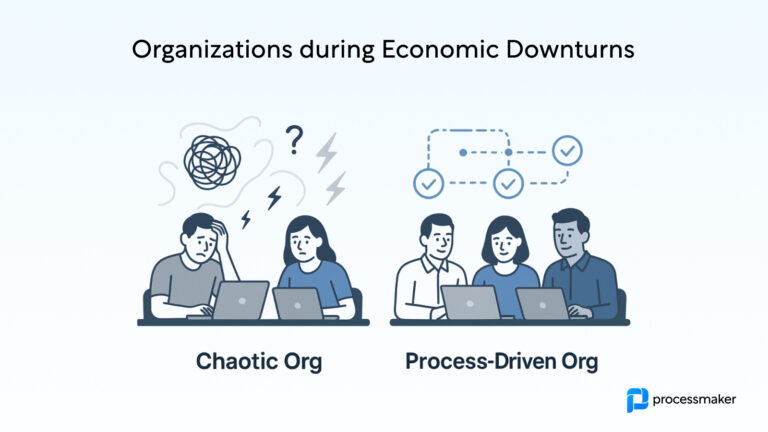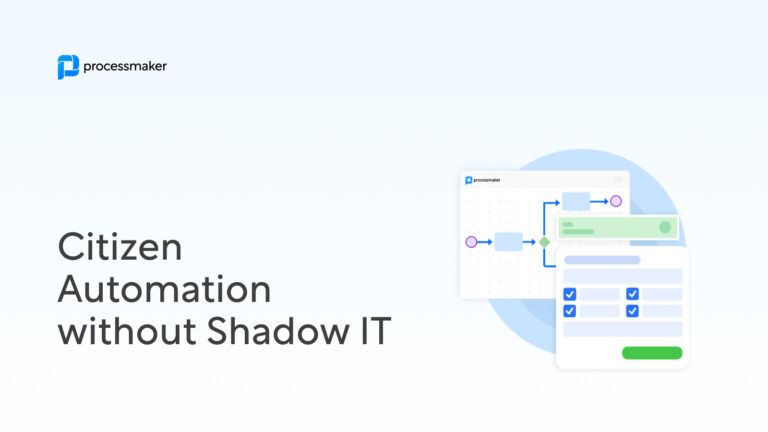Artificial intelligence
AI is a technology that enables systems to mimic human intelligence and behavior. In the context of business process automation, AI can help in the creation of operational process flowcharts, codeless script building, automatic generation of screens and user interfaces, and intelligent document processing. With the use of AI, businesses can describe their processes to an AI Assistant, which then translates the description into a comprehensive process model. This powerful technology can feasibly automate 60–70% of manual tasks.
Automation script
An automation script is a set of commands written to automate repetitive tasks and processes, eliminating the need for human intervention. Typically, these scripts are created using programming or scripting languages and can perform a variety of functions, from simple data entry to complex computational tasks. Automation scripts enhance efficiency and accuracy by consistently executing predefined actions at specified intervals or in response to certain triggers. They are widely used in IT operations, testing frameworks, data processing, and more, enabling businesses to streamline operations and reduce the time and resources required to accomplish routine procedures.
Business orchestration and automation technologies (BOAT)
BOAT, or Business Orchestration and Automation Technologies, is a group of software that streamlines and automates end-to-end business processes, seamlessly connecting various enterprise systems. BOAT technologies combine different capabilities such as orchestration, task management, process discovery and more. They use AI, process intelligence, and other technologies to provide a comprehensive toolbox for businesses to drive efficiency, reduce costs, and remain adaptable in a competitive market.
Business Process Automation (BPA)
Business Process Automation (BPA) involves the use of technology to execute recurring tasks or processes in a business where manual efforts can be replaced. It aims to increase efficiency, achieve digital transformation, and contain costs by integrating various systems and software to automate complex business processes, not just individual tasks.
BPA typically encompasses multiple departments and systems, linking them cohesively for seamless operations. Unlike Robotic Process Automation (RPA), which is typically task-specific, BPA is broader and involves a more holistic approach to optimizing a business’s entire workflow.
By implementing BPA, businesses can ensure increased accuracy, improved productivity, and reduce operational costs, while also minimizing human error. This strategic automation fundamentally enhances customer experience by ensuring faster service delivery and quality consistency, and it enables organizations to adapt quickly to changes in the business environment.
Business Process Management (BPM)
Business Process Management (BPM) is a systematic approach to improving an organization’s workflow, making it more efficient, effective, and adaptable to changing environments. It involves the design, modeling, execution, monitoring, and optimization of business processes. Unlike Business Process Automation (BPA), which focuses specifically on automating individual or sets of tasks within a process, BPM takes a broader approach that encompasses the entire lifecycle of a business process. BPM emphasizes the analysis and management of processes to ensure they align with the organization’s goals, while BPA is a subset of BPM that leverages technology to automate specific components of the workflows.
Business process optimization
Business process optimization involves identifying, analyzing, and improving existing business processes to enhance operational efficiency and effectiveness. This optimization process aims to streamline workflows, reduce waste, and maximize the use of resources to achieve better business outcomes. By improving process performance and removing inefficiencies, businesses can deliver higher-quality products or services, respond more quickly to market changes, and increase overall profitability. Business process optimization often works hand in hand with business process automation, as automating routine, manual tasks can be one of the most effective ways to achieve optimization.
Center of excellence
A Center of Excellence (CoE) is a dedicated team or entity within an organization that concentrates on establishing best practices, knowledge sharing, and continuous improvement in a specific domain, such as business process management, automation, or technology implementation. The CoE acts as a centralized resource for expertise, training, and strategic direction, enabling various departments within the organization to adopt and leverage innovations efficiently and drive process excellence.
Chatbot automation
Chatbot automation is the use of artificial intelligence and machine learning technologies to automate interactions with users through chat interfaces. These automated chatbots, often embedded within websites, apps, or messaging platforms, can handle a wide range of customer service queries, provide information, or assist with transactions without human intervention. By leveraging natural language processing, chatbots can understand and respond to user inputs conversationally, enhancing customer experiences by providing quick, reliable, and consistent support. This automation not only improves efficiency by handling routine inquiries but also allows human support agents to focus on more complex or high-value interactions, ultimately increasing operational productivity and customer satisfaction.
Conversational AI
Conversational AI encompasses a range of technologies that allow computers to engage in human-like dialogue. By using natural language processing (NLP), machine learning, and speech recognition, these systems can understand, process, and respond to user inputs in a conversational way. They power applications like chatbots, virtual assistants, and customer support solutions, enabling real-time communication. Unlike traditional rule-based bots, conversational AI learns from interactions, improving its responses and adapting to new inputs. This technology enhances customer service by providing instant support and information, reducing wait times and human workload.
Computer vision
Computer vision is a field of artificial intelligence that enables machines to interpret and process visual data from the world similarly to how humans do. It involves training computers to recognize patterns and objects within images and videos, allowing them to perform tasks such as image classification, object detection, and facial recognition. By leveraging algorithms and machine learning models, computer vision applications can automate tasks that require visual cognition, providing valuable insights and enhancing decision-making processes across various industries.
Digital transformation
Digital transformation involves the comprehensive integration of digital technologies into all areas of a business, significantly reshaping how organizations operate and deliver value to their customers. Unlike business process automation, which focuses on automating specific tasks or processes, digital transformation represents a holistic shift in an organization’s culture, processes, and service delivery standards to adapt to the rapidly changing digital landscape.
End-to-end process automation
End-to-end process automation ensures the automation of entire business processes from initiation to completion, providing seamless integration among disparate stages and systems.
Enterprise automation
Enterprise automation extends beyond singular processes, aiming to automate a wide range of operations throughout an entire organization, thus harmonizing various functional areas like finance, human resources, and supply chain management.
Graphical User Interface (GUI)
The graphical user interface (GUI) is a powerful tool that allows users to interact with software applications in a way that is both intuitive and visually engaging. Through the use of familiar components such as buttons, icons, and menus, GUIs simplify interactions with complex technologies, making them more accessible to a broader audience. This visual approach is especially beneficial for individuals who may not have extensive technical knowledge, as it eliminates the need to memorize intricate command codes or navigate complicated text-based interfaces.
Hyperautomation
Hyperautomation is a transformative approach that involves the deployment of advanced technologies, including artificial intelligence, machine learning, and robotic process automation, to automate processes at scale, often spanning across the entire organization. Hyperautomation aims to enhance and optimize tasks by leveraging data analytics and intelligent workflows, driving greater efficiencies across various functions.
Intelligent Automation
Intelligent automation combines artificial intelligence (AI) with traditional automation technologies to streamline and enhance business processes through advanced problem-solving capabilities. Unlike basic automation which executes structured tasks based on pre-set instructions, intelligent automation has the ability to learn and adapt by analyzing data and identifying patterns. This allows it to evolve and make informed decisions with minimal human intervention. By leveraging AI for tasks such as data analysis, customer interactions, and process optimization, intelligent automation improves efficiency, accuracy, and responsiveness.
Intelligent Document Processing (IDP)
Intelligent Document Processing (IDP) involves the use of AI and machine learning to automate the extraction and processing of data from documents. By converting unstructured data into actionable information, IDP enhances decision-making and operational efficiency. IDP applies intelligence to understand context and meaning, enabling more complex document workflows to be streamlined and optimized.
Low-code/no-code
Low-code and no-code platforms empower users to create applications with minimal or no programming knowledge, through visual interfaces and drag-and-drop features. These platforms democratize the development process, allowing businesses to accelerate digital solutions without extensive coding. Low-code/no-code offers agility and lowers the barrier to technology adoption, enabling faster and more inclusive problem-solving.
Natural Language Processing (NLP)
Natural Language Processing (NLP) is a field of AI that focuses on the interaction between computers and humans through natural language. By enabling machines to understand, interpret, and generate human language, NLP enhances communication and data analysis processes. NLP handles unstructured text, enriching automation with capabilities like sentiment analysis, language translation, and chatbots to process and derive insights from textual information.
Optical Character Recognition (OCR)
Optical Character Recognition (OCR) is a technology that converts different types of documents, such as scanned paper documents and PDFs, into editable and searchable data. OCR supports automation by enabling the digitalization of paper-based records, allowing for seamless data entry and document management. OCR bridges the gap between physical documents and digital systems, aiding in the full-cycle automation of document-intensive processes.
Process
A process is a series of steps designed to achieve a specific goal, functioning as the backbone of business operations. Well-defined processes ensure consistency, efficiency, and predictability in delivering outcomes.
Process intelligence
Process intelligence is a comprehensive approach that leverages real-time data analytics to evaluate and enhance business processes. It involves the continuous monitoring and assessment of process performance, allowing organizations to pinpoint inefficiencies, adapt to changes, and optimize workflows. Unlike other discovery approaches, process intelligence can analyze end-to-end processes, bringing visibility over both processes and tasks. It plays a crucial role in strategic decision-making, offering a comprehensive view of how processes function, identifying potential bottlenecks, and suggesting actionable improvements to bolster productivity and operational excellence.
Process mapping
Process mapping is a systematic approach to visualizing the sequence of actions and decisions involved in a specific process. By creating a visual representation, often in the form of flowcharts or diagrams, process mapping allows organizations to better understand and analyze the way tasks are executed. This tool is instrumental in identifying inefficiencies, redundancies, and areas for improvement within a process, providing a clear picture of workflows from start to finish.
Process mapping facilitates communication and collaboration among teams, ensuring that everyone has a unified understanding of process details. This clarity supports the implementation of business process automation by highlighting which steps can be streamlined or automated, thus contributing to enhanced efficiency and better resource allocation. Through detailed analysis and visualization, process mapping lays the groundwork for optimizing workflows and achieving organizational goals.
Process mining
Process mining is a data-driven technique that analyzes the flow and performance of current business processes by extracting insights from readily available event logs. Unlike traditional approaches that rely on assumptions and predefined models, process mining offers a factual, evidence-based perspective on how processes are actually executed. This methodology enables organizations to uncover inefficiencies, bottlenecks, and deviations from intended workflows.
By leveraging process mining, businesses can gain a deeper understanding of their operations, identifying areas that are ready for improvement and automation. The significance of process mining is further highlighted by its ability not only to facilitate the discovery of existing processes but also to support continuous monitoring and optimization, ultimately enhancing operational effectiveness and fostering strategic agility.
Process monitoring
Process monitoring involves tracking the performance of business processes in real-time to ensure compliance and efficiency. It allows organizations to detect issues early and take corrective actions promptly. In contrast to business process automation, which focuses on executing workflows, process monitoring provides ongoing oversight to maintain optimal operations and enhance long-term operational resilience.
Process orchestration
Process orchestration is a crucial strategy in achieving end-to-end automation, as it ensures all applications, AI tools, bots, personnel, and existing software work in harmony. It transforms your workflow by boosting hyperproductivity, providing real-time insights into all ongoing processes, identifying redundant tasks, ensuring regulatory compliance, and easily integrating new technologies. With process orchestration, you can eliminate the risk of “shadow apps” and gain a comprehensive, end-to-end view of the entire operation. Whether in healthcare, finance, or higher education, any industry running complex, multi-layered processes can significantly benefit from process orchestration.
Robotic Process Automation (RPA)
Robotic Process Automation (RPA) is a technology that utilizes software robots, or “bots,” to automate repetitive and rule-based tasks traditionally performed by humans. These tasks often include data entry, processing transactions, or managing digital records. RPA is designed to operate existing applications just like a human user, engaging with the user interface to automate workflows without the need to modify underlying systems.
By automating mundane tasks, RPA frees up human resources to focus on more strategic and innovative work. RPA can be quickly implemented for specific tasks, providing rapid returns on investment. RPA’s ability to seamlessly integrate with existing systems also supports scalability, making it a valuable asset for organizations looking to streamline operations and improve productivity.
Task mining
Task mining is a specialized analytical approach that focuses on capturing and analyzing the granular level of activities performed by users in their day-to-day tasks. It utilizes advanced technologies like machine learning and natural language processing to record detailed user actions, such as keyboard and mouse interactions, to understand how tasks are executed within specific user interfaces. Unlike process mining, which deals with overall process flows using event logs from IT systems, task mining delves into user-level intricacies to identify inefficiencies, bottlenecks, and areas ripe for improvement.
Workflow automation
Workflow automation refers to the design, creation, and implementation of automated processes that eliminate manual tasks within a business workflow. By utilizing software solutions, workflow automation streamlines a sequence of tasks, routing information to the appropriate parties automatically, and ensuring that predefined actions are triggered under specific conditions. This automation simplifies complex processes by reducing the need for human intervention, thereby minimizing errors, accelerating task completion, and increasing overall efficiency. It plays a significant role in business process automation as it focuses on optimizing workflows, enabling consistent outcomes, and freeing human resources from tedious repetitive tasks to focus on more strategic activities.





